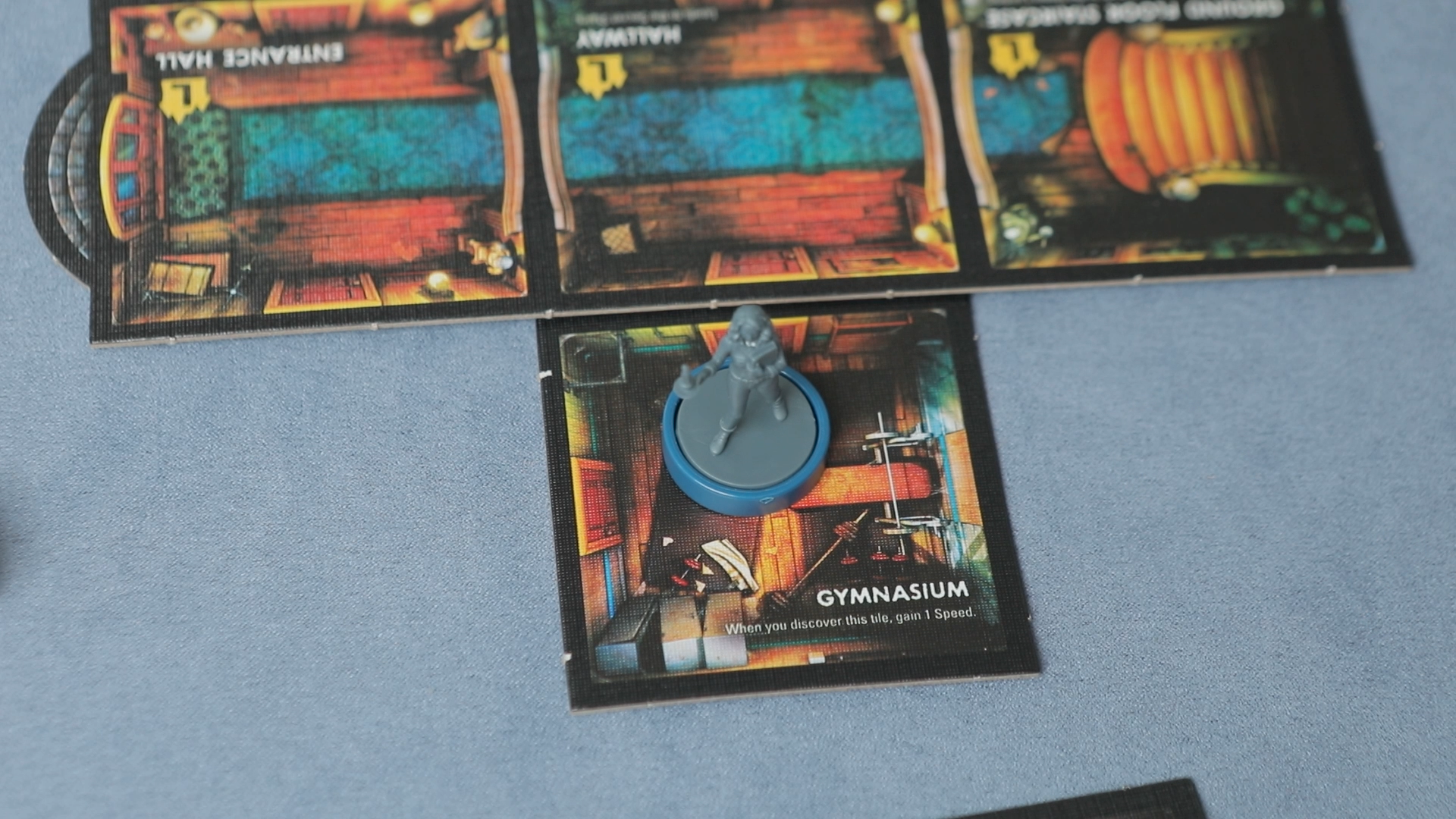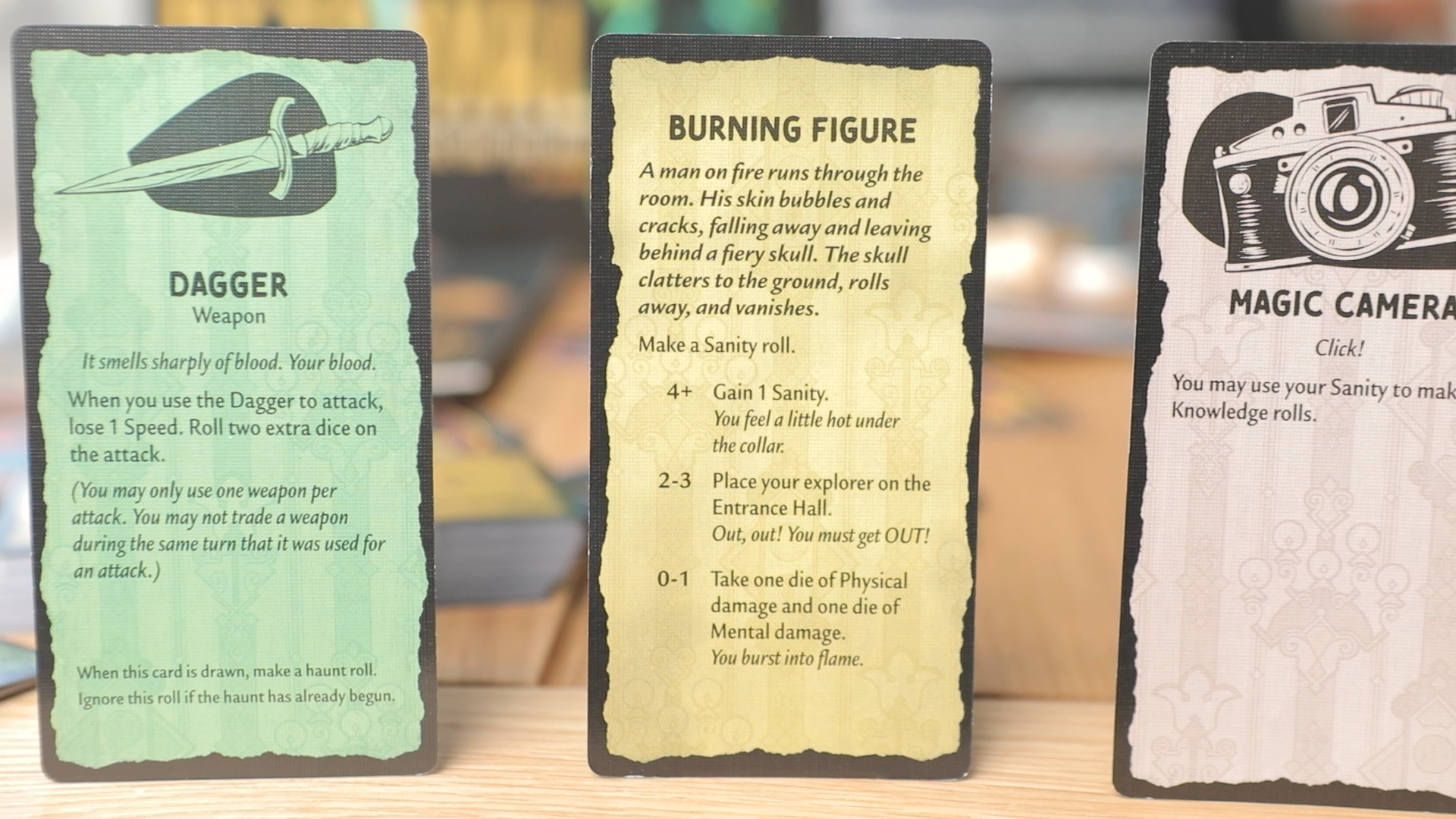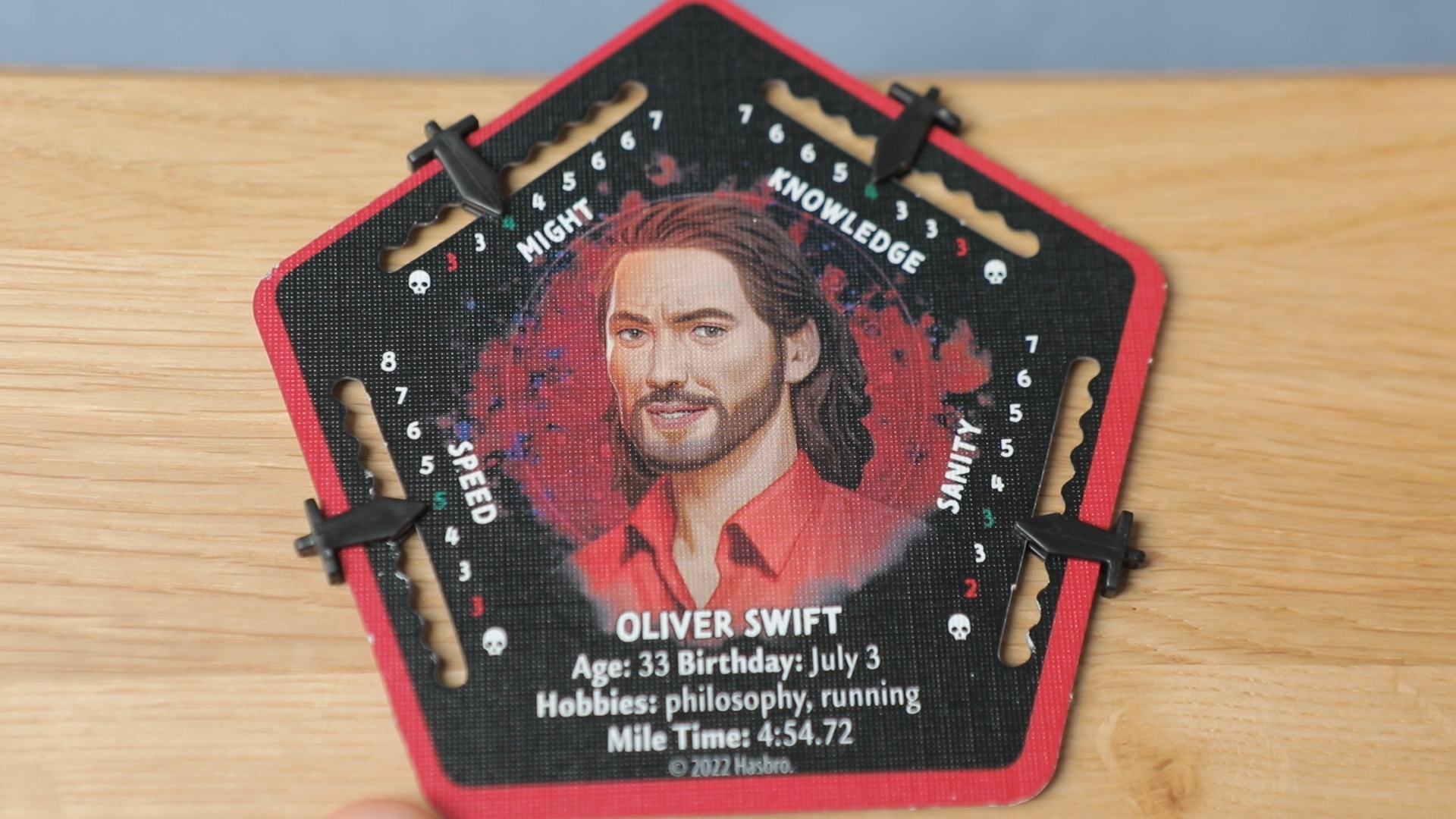Betrayal at House on the Hill (3rd Edition) Review
Far from perfect, but get this streamlined version over 2nd edition for a spooky night in.
Play the two halved game of exploring an abandoned house, then playing out a B-movie-like horror movie in the second half, called a Haunt. In Ameritrash fashion, players will interact with events, omens, items, and even hidden win conditions when the haunt is in play. Runs between 60-90 minutes, for 3-6 players.
Video published October 27th, 2022

Explore the house, then trigger 1 of 50 new Haunts!

Trigger events, omens, and items with a new system to trigger Haunts.

Face a revealed Traitor, who (probably) is trying to kill all the investigators!
Overview & How to Play
During Halloweens since 2003, board gamers think of this unique two halved spooky game: Betrayal at House on the Hill. One part exploring a house, then there’s a reveal, and there’s Halloween styled killing in that house called a Haunt. But the problem was in those 50 different haunts, there were rulesets that just didn’t work or were super poorly worded!
Avalon Hill listened to the complaints… mostly! So, gather around for what 12 years of development since 2nd Edition’s release gets you!
Betrayal’s premise is that there is a haunted/abandoned/creepy, and it’s unexplored! So us characters will take turns slowly revealing rooms in this house, triggering events, and getting items… or finding special items called OMENS. Omens are as spooky as they seem, once you find one, you must make a Haunt roll, now rolling dice equal to the amount of omens flipped. If you get a 4 or below…. Nothing happens, keep exploring. If you get a 5+… THE HAUNT TRIGGERS!
This revealed scenario is second half main squeeze of the game, where a certain player is determined to be a traitor aka bad guy, getting a new hidden win condition to defeat the rest of the players who now work together as a team! These booklets tell you all the new secret stuff: some important backstory, new actions each team can take, and of course each side’s special new win condition.
In Ameritrash fashion, each player is playing a specific person, each with a certain amount of 4 stats- if any of them drop to a skull, they die and are out of the game. They’ll use stuff like their speed stat to move around the map, current might to perform attacks to roll dice to see how strong that attack is, and exploring a new room doesn’t take any dice rolling checks, ends your turn, but lets you trigger a type of card, including letting you find and grab items. Items you’re just looting from rooms might give you extra traits or actions to do too! And of course once the haunt starts, both good guys and bad guys will get more special actions determined by their booklets.
But yeah the game is that simple, you just keep passing off turns like this until one side achieves their hidden agenda: could be kill everyone else, exorcise some demon, escape, you get the idea- supernatural voodoo magic stuff. It’s all in this game, get that, you immediately win the game.
Pros
Betrayal 3rd Edition is certainly more 2022 looking! It looks bright and vivid, with especially the 45 tiles looking facelifted from before. Also character portraits are colored in to really spur your imagination. Their minis have super clear bases and feel secure into going into their mold in the insert! The dice are no longer white, but now a nice off-white that could remind some of human bones.
As for learning now, the rulebook is super well laid out and very concise: with plenty of symbols, examples, and intuitive organization everywhere. If you’re a Betrayal veteran, all you need to know is laid out on a single page to save tons of time! Then just jump to any part with an exclamation mark in the rest of the rules.
And thank goodness Betrayal has player aids now- one for normal heroes, one for the traitor, and even one for the monster’s turns!
For the Betrayal spooky theme, it’s pretty much the same as before: truly Ameritrash, emphasis on the American horror vibe. You’re plainly just idiots in a b-movie going into some abandoned house. You got little kids, high school athletes, and doctors- you got everyone from all sorts of walks of life. These are in 6, double-sided player boards with unique stats (12 characters), and even some nice little tidbits for roleplaying, like Hobbies, GPAs, Mysteries Solved, etc. It’s all fleshed out more with backstories in the rulebook.
The gameplay at its core is pretty much the same as Betrayal 2nd Ed: a really unique premise of a game split into 2 connected halves: one half being pure exploration, then the second half is… well kinda anything can happen with the 50 different haunts! Since Haunt booklets are hidden for each side, you’ll play the second half Haunt by experimenting with different items and locations on the board, trying to guess their opponent’s hidden flaws and win conditions, teamwork usually necessary. All throughout the first and second half of the game, any supernatural thing can happen as you keep exploring the house.
Maybe there will be technical difficulties with an elevator to make you fall to the basement. Or you hallucinate random funerals. Or you’ll find weird stuff, like strange medicine you shouldn’t drink but… but will… or a sick leather jacket to wear. Or just rev up with a chainsaw.
Sometimes the game won’t be a traitor peeking over the traitor’s tome trying to exploit some EVIL advantage, because haunts can end up being a free for all, full coop, or even have hidden traitors! For more on the Betrayal formula, check out our 2nd Edition review here.
We’re here for 3rd Edition, so now we gotta talk bout the cool gameplay changes from 2nd Ed. They now have a method to help fix the possibility of haunts triggering too early or too late!
So now you cannot get Haunts on the first omen because you need to roll a 5 on the special dice to trigger it, and you only roll 1 die that has a max value of 2. You also can’t get it on the second because that only lets you roll 2 dice, max value there is 4. If the deck of 9 omens runs out, a Haunt immediately triggers, so no more waiting way too long for the Haunt to happen.
Plus, every time you start a game, you pick one of the 5 scenario cards, which give you an opening hook to why the heck you’re in this house. Maybe you’re just a team of investigators like Scooby Doo, or are desperate to investigate some “cheap” real estate. When the Haunt is triggered, just flip this card over, and it’ll tell you exactly where to go, super fast, and the Haunt will be at least somewhat tied to the initial premise.
And my gosh, the Haunt booklets function SO much better. Not only is it dividing with separate colors, but it has clear boxes to guide your attention. It doesn’t do the weird 2nd Edition thing of mixing flavor text and mechanics to get the instructions across.
Then abilities have been reworked, like stealing is removed from the game, which was an extremely swingy action to steal another player’s item through might rolls. No more stealing someone’s CRUCIAL item for a Haunt and then just getting away with the game. Or how about whenever there is an ability you can do, it has a symbol matching it, making it easy to reference.
Then there’s a nice rule that if you’re doing a secret action, you must read it aloud, which helps stifle those sleazy players that just ‘did’ secret actions in 2nd Edition because the Haunt says they can, but the player never explained why, and you had to take their sketchy word for it.
And the heroes can’t game monster movement as much, with a fantastic change that monsters can just move from the basement landing to the ground landing and vice-versa. Why is this so good? Well, players are the only ones that can use special rooms to yeet out of the basement, and there’s only 2 other rooms that will let you just walk from the basement normally. In 2nd Ed, it wasn’t too uncommon to see monsters getting trapped in the basement and being useless.
Also the tiles are now streamlined, now once you explore tiles, you will just get it’s buff, that’s it no frills no nonsense. 2nd Ed had a super fiddly system of marking it for your specific player. Or how the junk room will just straight up spawn an obstacle that has its own text on it, instead of 2nd Ed having you to make a roll every time you had to leave.
Basically all this streamlining makes Betrayal run shorter in a healthy way, so much closer on average to the 60-90 minutes on the box… but its Betrayal and anything can happen.
Cons
We have to start with the haunts, since while they’re streamlined and clarified, they’re still pretty unclear at times!
The variable player count indicator should have been more direct, but more importantly, when it tells you to read things out loud, the booklets need to tell you exactly what to say or NOT say, since if your read the entire action sometimes, you’ll just spoil your win condition! Was that intentional? There’s also some overly simplistic wording that is too ambiguous, like “monster does not take damage from attacking humans’, that could be interpreted 2 ways: either from the monster doing the attack itself, or humans attacking it.
Betrayal NEEDS to hide information in the booklets, and the moment players have questions and start having to show the booklet to one another, the hiding of the information is purely up to the players. There’s much less of this confusion now compared to 2nd Ed, but it’s still here.
Then the cardboard bits feel very Hasbro-y still- small monsters are hopelessly generic, bigger monsters aren’t much better, and text is hard to see. And the insert just wants you to put all of the small tokens into one pile which is well… disgusting for organization.
More text is hard to read: like on tiles for special abilities, or hero traits for green numbers. Some doors are also hard to see because they blend in with the current orange-y direction of many rooms, which wasn’t a problem at all with the more unsaturated rooms in 2nd Ed. Like if you look at the mystic elevator, one is prettier, but the other is just easier to look at in general. And the notches on the new player boards are a good idea, they don’t actually work that well to separate numbers, and we’re worried these will cause more wear on the rather thin player boards.
Speaking of text, the player aids also aren’t perfect, where it really needs to stress the new rule: when you explore something, it immediately ends your turn!
And then the tiles, man they are thin! We haven’t had this game for long and they’re already sticking up, so you have to have them all lined up perfectly not have this springy effect. What’s probably the worst is that the tiles stick up on table by themselves, not fun when tiles going under each other during gameplay.
Nitpicks
First let’s talk about the omens. There’s only 9 omens now in the game, 4 less than 2nd Edition’s 13. This was done to add more consistency to the game- less omens that have weird abilities- the less weird board states you will have. But with only NINE omens in the game, you’ll frequently draw through most if not sometimes the entire deck each game. Also, if omens have simpler abilities compared to 2nd edition, there’s a damper on haunt depth.
Because…. if they’re streamlining the omens, they’re streamlining the Haunts right? Well, we’ve only played 2 Haunts, but we went ahead and massively spoiled the heck out of ourselves by reading through both good and bad guy books for a handful of scenarios.
The scenarios we’ve read seem fine at a glance, but do be warned that some seem so streamlined to the point of being too simple. This is especially gonna hurt the coop scenarios, since those in 3rd Edition just has less nuanced items and weird abilities for your team to puzzle around. There was even a coop scenario that we found that had players cleaning the house, which looks like it functions, but seems extremely simple and thematically poor.
The last nitpick is yep, the Haunts still have room for unbalance. That’s just going to happen in a simple game with emergent win cons, where sometimes the traitor will just happen to be loaded with the best items, or sometimes the specific locations you need for your win condition are all on the bottom of the tile deck.
Like to fix this, you could use an app, or make the Haunt selection process more technical, or make each Haunt more specific in setup. Those things would pretty much require you to revamp the game and/or make it way more wordy, which kind of goes against what Betrayal is though. Luckily the game has built in rules now to pick a new traitor for when the Haunt triggers.
Final Thoughts
Betrayal at House on the Hill 3rd Edition is clearly better than 2nd Edition, but we went ahead and gave both games a 7/10. 3rd Edition wasn’t quite good enough to get elevated to an 8/10, and didn’t solve everything while simultaneously doubling down on streamlining.
With that, 2nd Edition players might be surprised on the simplicity of abilities, cards, and haunts overall, for a less thematic night. This trade off will be totally worth it for most players: a game that’s easier to play and have haunts that actually work most of the time! It’s going to be way less TERRIFYING to hand a newcomer friend the traitor tome, which was one of the biggest barriers of 2nd edition. Like, straight up, the amount of times we had to STOP playing 2nd Edition because there was a dispute in the rules was asdflkjasldfkasdf terrible. And we’re probably not alone there.
Before in 2nd Ed, you were playing to half make up your own game, or expect to restart if you got a shoddy haunt. Now that’s WAY less likely to happen, so the mechanic parts of Betrayal now WORK, with perhaps a little less charm. Tiles have less decisions to make, or items (see Gun) are frequently reduced to one ability. Or swingy stuff like the dark dice have been completely axed. If you’ve played with Widow’s Walk before, gone are dumbwaiters to use as shortcuts, or super nuanced locations like the Solarium and Laundry. Rooms in 3rd edition can feel pretty vanilla and same-y on their own sometimes, which is par for the course of streamlining.
But the Mystic Elevator is still here, there’s still fun weapons, there’s 50 new haunts, and the gears of everything actually turn without putting on your game designer cap mid game.
Today, the only reason you would want to get 2nd Edition is if you have a group that is super chill on rule clarity and enjoys so much of the flavor text, nuanced but potentially messy items, room abilities, and maybe even enjoys… let’s face it… basically Calvin-balling of rules. For for the vast majority of people, if this pseudo-party Ameritrash game is something you’d like, just get 3rd Edition. If you didn’t like the Betrayal formula before, it’s still not gonna be your type of game, but if you did, now it’s more of an actual game.
Oh, and warning, the Widow’s Walk Expansion is NOT compatible with 3rd edition, so be warned, because we have seen plenty of new Widow’s Walk expansions still in stores, and we wouldn’t want someone to get betrayed by their purchase there.

























